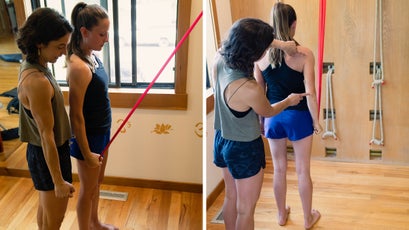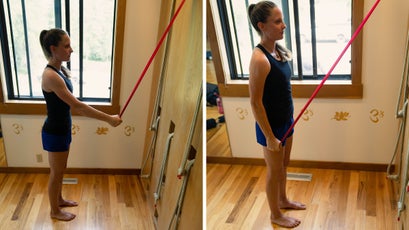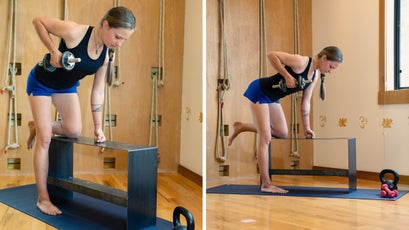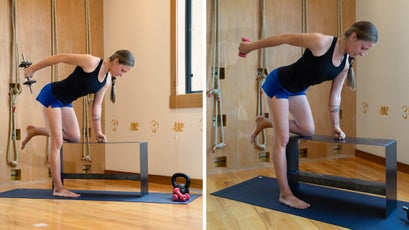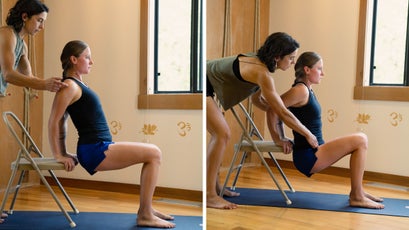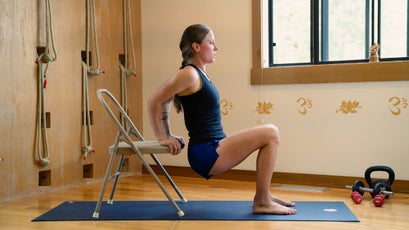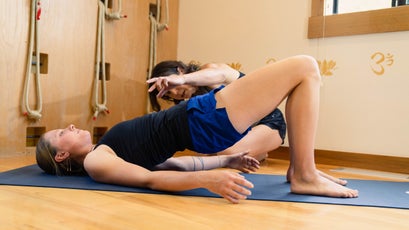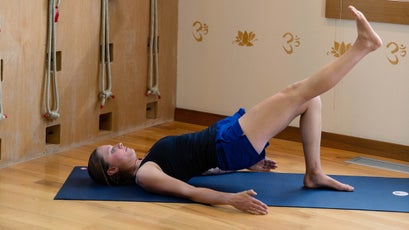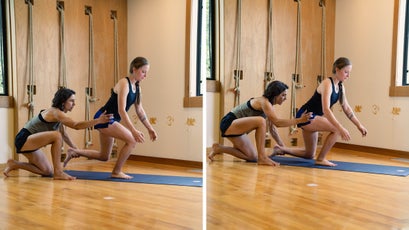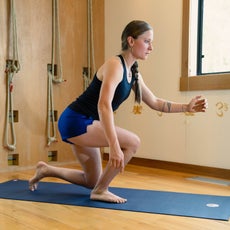5 Moves to Engage and Strengthen Your Glutes and Triceps
“],”renderIntial”:true,”wordCount”:350″>
In the course of a prolonged layover in a major airport the other working day, I viewed hundreds of men and women stroll and operate to their gates. I could see why so many widespread orthopedic complications, like lower-again suffering, hip arthritis, and plantar fasciitis, are triggered by how we transfer. Someplace together the way, many of us have dropped touch with our intuitive gait and designed inefficient designs, letting the front of our bodies do the work rather of our powerhouse posterior chain. To place it simply, we really do not use our backside—our buns and our guns.
The way we stroll is a products of both of those evolution and realized behavior. Conveniences of modern everyday living impact biomechanics: treadmills really do not involve you to push to transfer forward, some home furnishings gets rid of your need to get up from the flooring, and grocery retailers are intended so you hardly ever need to climb or squat to attain food items. Cultural influences and footwear decisions alter our movement designs, as well: youngsters stroll likewise to their moms and dads, men and women of the identical cultural qualifications frequently screen identical gaits, and large heels and cushioned sneakers alike will adjust your stride.
When you stroll, you arms need to swing reciprocally with your legs, propelling you with a pattern of extension and flexion. Your triceps muscle mass engages to attract your arm at the rear of you, stretching the comfortable tissues of the chest like a rubber band that then releases to spring the arm forward with absolutely free, elastic strength. That elastic movement can support offset some of the work accomplished by the front of your overall body. If you can harness your posterior chain successfully, you also gain from amplified energy and endurance from the glutes, decreasing your chance of harm. If you’ve ever dealt with hip-flexor suffering, anterior-knee suffering, or lower-again pain on a prolonged stroll or operate, then you might deficiency again-line participation.
Listed here are five easy moves that can develop again your triceps and glutes and get you moving like you ended up intended to.
The Moves
Triceps Toner with Band
What it does: Helps you follow an economical pattern of flexion and extension in your higher overall body, whilst strengthening your triceps. The resistance band encourages you to interact the again of your arm through extension and take it easy into the forward arm swing.
How to do it: Stand with an physical exercise band anchored earlier mentioned you. (You can tie a knot at the conclusion of the band and position it more than the major of a doorway. Shut the doorway so that the knot is caught on the other aspect.) Stand struggling with your anchor place, and grasp the band with one arm, holding it straight and prolonged in front of you at roughly a forty five-degree angle. Applying your triceps and the muscle tissue at the rear of your shoulder in the vicinity of your armpit, pull again towards the band, moving your entire arm straight at the rear of you, past the midline of your trunk. You need to really feel your shoulder blade slide towards your spine. Then take it easy and permit your arm to swing forward passively in one sleek, slow movement. You need to really feel your shoulder blade take it easy into a neutral placement. Retain your elbow straight the entire time. Soon after education this pattern with the band, try out transferring this reciprocal action to walking and functioning so you tone your triceps with every stride.
Quantity: 1 to a few sets of ten to thirty repetitions on each individual aspect. Relaxation one minute involving sets. Complete this movement frequently during the week to support retrain your mind.
Bent-Row Triceps Toner with Free of charge Weight
What it does: Will work the triceps and muscle tissue together the again of your shoulder. The bent-more than placement encourages you to stabilize your trunk and interact associated muscle tissue towards the absolutely free bodyweight and gravity.
How to do it: Put your left knee on a bench, and stabilize with your left fist. Retain your hips and shoulders level. Let your absolutely free arm cling perpendicular to the ground, bodyweight in hand. Bend that arm to row the bodyweight up beneath your shoulder, then prolong your arm again, at the rear of the midline of your trunk. Be absolutely sure to absolutely straighten the elbow in this article. You need to really feel your shoulder blade slide towards your spine. Reverse the transfer by bending your elbow, releasing your shoulder blade absent from the spine, and slowly but surely reducing the bodyweight again to the starting up placement. Select a bodyweight that allows you to absolutely straighten your elbow at the conclusion of the move—it might be shockingly gentle.
Quantity: 1 to a few sets of five to 8 repetitions on each individual aspect. Relaxation two to a few minutes involving sets. Complete this transfer one to a few occasions for each week.
Triceps Dip with Upper body Opener
What it does: Shoulder extension might really feel overseas, given how considerably time most of us devote engaged in forward-oriented postures and actions, like typing or texting. This transfer orients the shoulders into total bilateral extension, allowing us to place the work into the triceps rather of the chest. Folding at the hips whilst maintaining a vertical spine is an added obstacle with an open up chest.
How to do it: You will need a stable chair and grippy flooring area. Commence with your palms on the chair at the rear of you, fingertips forward. This placement encourages the shoulder blades to pull again towards the spine and down towards your buttocks. Retain your trunk vertical, with your hips near to the front edge of the chair. Commence bending both of those elbows, reducing into the dip. Only go as very low as you can retain very good type: shoulder blades squeezing towards the spine, chest wide and open up, feet and knees parallel, and elbows narrow at the rear of you. If reducing into the dip feels as well really hard, just maintain the starting up placement. Drive again up to straight elbows and repeat. Retain your again near to the front edge of the chair through the entire movement.
Quantity: 1 to a few sets of a few to 8 repetitions, with two to a few minutes of rest involving sets. Complete this transfer one to a few occasions for each week.
Solitary-Leg Bridge
What it does: Engages the posterior chain with no considerably margin for cheating. When you have to push your trunk up and forward applying a solitary leg, you get a really feel for how considerably your bottom need to be doing work to push you forward when you are walking, hiking, and functioning.
How to do it: Commence by lying on your again, with your knees bent, your feet flat on the flooring and hip-width apart, and your shins vertical. Your arms need to rest by your sides, palms struggling with down. Interact the backs of your shoulders, arms, and fingers by urgent them into the flooring. Then push your feet into the ground and carry your pelvis up into a bridge, drawing a straight diagonal line from knees to chest. Think about pulling your heels towards your bum, which need to support activate your glutes and hamstrings. Raise and prolong one foot, then lower your pelvis down to the flooring and again up with that solitary leg. If you cannot carry and lower, maintain the one-legged bridge placement for thirty seconds. The the vast majority of the work in this transfer need to be concentrated in the again of your hips and legs, not in the quads or lower again.
Quantity: 1 to a few sets of five to 8 repetitions, with one to two minutes of rest involving sets. Complete this transfer one to a few occasions for each week.
Reverse Lunge
What it does: When you stroll, your glutes stabilize the pelvis and initiate hip extension, delivering a impressive push forward that extends all the way down your posterior chain to the foot. This physical exercise can help you discover the origin of that movement whilst in a standing solitary-leg placement. It also troubles harmony.
How to do it: Commence by standing in a squat-completely ready placement, with your feet hip-width distance apart. Shift your bodyweight to one leg and prolong the absolutely free leg at the rear of you into a reverse lunge. Consider to lower the again knee to in just an inch of the flooring and touch just the toes of that foot to the ground. Then interact your glutes and hamstrings on both of those sides to elevate again up to the starting up squat placement with small again-foot make contact with time. This puts the bulk of the work on the front leg and need to bias the glutes a lot more than the quads. If you really feel wobbly, decrease the distance of the reverse lunge or use two trekking poles for help. If it feels as well effortless, incorporate absolutely free weights in both of those fingers.
Quantity: 1 to a few sets of five to 8 repetitions on each individual aspect, with two to a few minutes of rest involving sets. Complete this transfer one to a few occasions for each week.
Esther Smith, a health practitioner of bodily remedy accredited in Mechanical Analysis and Treatment, has specialized in treating athletes (specifically rock climbers) for the past 10 years. She is a storyteller, a mountain athlete, and a large-overall performance mentor for the Samsara Experience. You can discover Smith’s published and movie methods cataloged at Grassroots Self Therapy and learn a lot more about her bodily-remedy follow at Grassroots Actual physical Treatment.

